|
|
|
 |
|
|
|
|
|
|
|
|
|
Carr & Bury
|
|
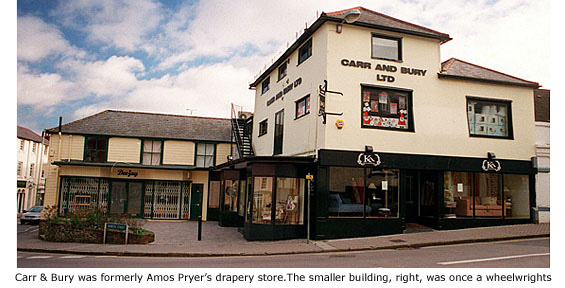
On this site, previously used by Hawkes Brewery, Amos Pryer established his drapery and haberdashery business in the larger part of the property in the 1891. He later added an extension to the side of a wheelrights next door to create a new shop front. Highly regarded in the town, Amos held several positions in public affairs and was the People's Churchwarden at St Michael's church. But in 1916 failing health led him first to Sussex then to Harrogate, Yorkshire, where he died on 20 November, aged 60 years. His wife, Annie, died in Bishop's Stortford in 1935 and his only son Alfred A Pryer, who served as a Captain in the Army Veterinary Corps during the First World War, died in 1943.
In 1924 the shop was bought by a well known East Anglian draper Edgar Carruthers and his business partner Mister Tidbury, who combined their names to establish Carr and Bury as a linen and drapers wholesalers. They sold the shop soon after the end of World War Two to a Mister Mullinder of Harlow, who in turn sold it to John Collett and his wife Ruth in 1955. John Collett had previously run a hosiery business in London before joining aircraft manufacturer De Havillands at Hatfield, Hertfordshire. Unfortunately John died the following year, cutting short their plans to develop the shop. 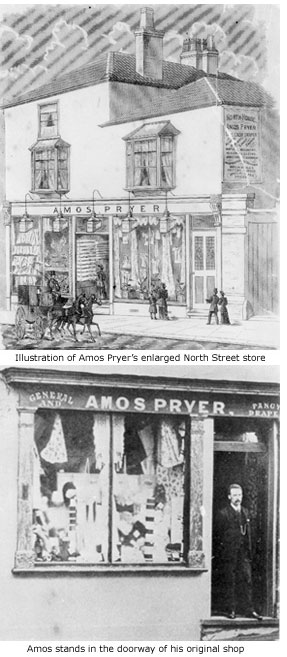 That was when their younger son Peter became involved on a full-time basis, giving up his career in the City to become managing director of Carr & Bury, with his mother as Chairman. They were then joined by Jean Barge, who managed the company's finances and later, following Ruth's death in 1985, became Chairman. That was when their younger son Peter became involved on a full-time basis, giving up his career in the City to become managing director of Carr & Bury, with his mother as Chairman. They were then joined by Jean Barge, who managed the company's finances and later, following Ruth's death in 1985, became Chairman.
Through the 1960's and 70's the business flourished, building up a large and successful dress fabric and haberdashery department. But from the 1980's onwards it soon became evident that the business had to adapt to the fact that the development of 'off the peg' outfits meant fewer people needed fabric to make their own clothes. The other major social and cultural development affecting trade at that time was the demise of the teaching of 'home economics' - and the sewing classes that went with it. Nevertheless, while the overall number of drapers and fabric shops rapidly declined in Britain, Carr & Bury succeeded in attracting customers who still had an eye for sewing.
In 1983 Peter Collett's son Henry became the third generation of Colletts to join the business. His involvement allowed Peter the time to extend his participation in various local and national trade bodies, and in 1996 he was elected the first chairman of the British Shops and Stores Association. At the start of the 1990's, Carr and Bury opened a shop in nearby Great Dunmow as the company looked to build on its strong reputation as one of the few remaining family businesses in the area. In 1994 Henry Collett took over from his father as managing director.
In the year 2000 Carr & Bury was totally refurbished and became the first outlet in the UK to sign a franchise agreement with Spanish furnishing company, KA International. Although a short lived partnership, the franchise ending in 2004, it did develop the company's home furnishings market and most recently (2009) the tie up with French Company Toiles de Mayen.
In 2011 Carr & Bury moved from North Street to premises next to Thorley church.
No 42a:
This was once a hairdressers and later an upholstery shop. In 1911 the corner plot outside the shop was the garden of Amos Pryer, and where now there are raised rose beds once stood Mr Pryer's greenhouse.
|
|
|
|
Water Lane (Hawkes Brewery)
|
|
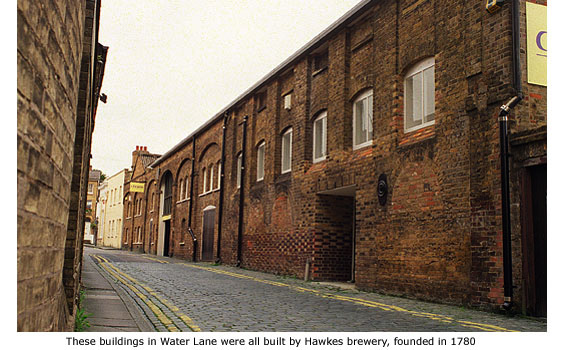
When the Saxons first settled here this lane was one of two back lanes running parallel with North Street – the other is Basbow Lane (See Guide 2). And, so far as is known, Water Lane, or Watery Lane, was the lane’s ancient name, derived no doubt from the fact that it ran parallel with the (original) river course. Only once has its name changed in all those years, shortly after 1780 when Hawkes brewery was established here and this section of roadway was renamed Brewery Lane. The company was founded by William Hawkes, Thomas Bird and William Woodham with money earned from supplying malt to London breweries via the Stort Navigation (opened in 1769).
The Brewery was sizable, stretching north from Water Lane to Northgate End and east as far as the river where Waitrose supermarket stands. Now, the only evidence of the brewery’s former presence here are the buildings that currently line Water Lane, including that once occupied by Midland Bank at the corner of North Street. Closer inspection of the walls reveal they have been ‘capped’ at present roof height, the original buildings standing much taller with the largest being five storeys high.
Cobble stones still form part of the lane’s road surface, while beneath it runs a tunnel once used to move barrels back and forth between the brewery and nearby malthouses. This tunnel has since been sealed and now stretches from the Charis Centre only as far as JR’s bar, also once a part of the original brewery.
Hawkes Brewery was the town's largest employer, and in 1789 began to increase its business interests by buying up local pubs. But on 26 February 1794 its founder, William Hawkes died, aged 39. Without certainty, his wife Elizabeth probably took over the running of the business, then later passed it on to her and William's only son, William Robert Hawkes. Elizabeth died in 1839, aged 81.
At what age William jnr took over the firm is unknown, but it would seem he inherited his father's business acumen: company accounts of 1831 showing ownership of 13 pubs, the brewhouse and liquor house, a house and maltings, and a bank. Hawkes also leased farmland, possibly for growing barley, the annual cost of which was £146. 15s.
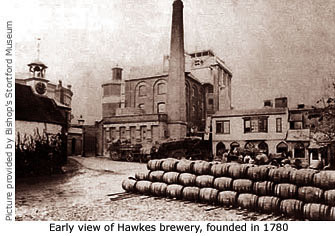 In 1846 William formed a partnership with Frederick Nash, a brewer in South Street, the firm then becoming 'Hawkes Nash & Co, brewers, maltsters & wine & spirit merchants'. But the partnership was short-lived and the name Nash disappeared from the title by 1850. The following year William formed Hawkes & Partners, then set about a rapid expansion of the business by purchasing more and more local and district public houses. In 1846 William formed a partnership with Frederick Nash, a brewer in South Street, the firm then becoming 'Hawkes Nash & Co, brewers, maltsters & wine & spirit merchants'. But the partnership was short-lived and the name Nash disappeared from the title by 1850. The following year William formed Hawkes & Partners, then set about a rapid expansion of the business by purchasing more and more local and district public houses.
William Robert Hawkes died in May 1859, aged 74. Despite the fact that Bishop's Stortford had been his home, and that his parents were buried in St Michael's churchyard, it was William's wish to be interred in the vaults of Westgate Chapel, Wakefield, Yorkshire.
What happened to ownership of Hawkes brewery immediately after his death isn't certain, but at some point between 1859 and 1898 it was bought by James Wigan and his son James Lewis Wigan. Once again the brewery's name changed, this time to the more familiar Hawkes & Co, and over the next 30 years or more the Wigans' increased their property portfolio to 164 pubs in East Hertfordshire, South Cambridgeshire and West Essex - 9 of which were leasehold. They also owned a considerable amount of other property that brought in a rental of £5,000 per annum.
In August 1898 Hawkes & Co was the subject of a take-over by Benskins Brewery, the owners, James Wigan and his son James Lewis Wigan, being paid the sum of £270,000.
Benskins expected profits from their take-over was £20,000 per annum. They promised no changes to employment or working practices, and were as good as their word until 1916 when they sold the brewery to Ind Coope. They used it solely as a distribution depot until 1987. The site of the depot then stood vacant until 1994 when it was bought and developed by Waitrose.
*A junior clerk of Hawkes, William Powter, who died in 1827 aged 31, was buried close to the Hawkes’ family tomb in St Michael’s churchyard. His gravestone describes him as ‘an assiduous, honest and faithful servant’.
Charis Centre
Sometime after the actual brewery ceased to operate in 1916, a storage building in Water Lane was taken over by Colvin Watson & Co for use as an auction house. When they moved out in the late 1980s it became, briefly, an indoor market, but since the early 1990s has been occupied by an independent church group and known as the Charis Centre.
Formed in 1983, this Community Church works in tandem with over 200 other churches in England and abroad under the banner of New Frontiers International. It is also a member of the Evangelical Alliance. Charis, pronounced ‘Karis’, is the Greek word found in the Bible for 'Grace'. MORE PICTURES
|
|
|
|
United Reformed Church
|
|
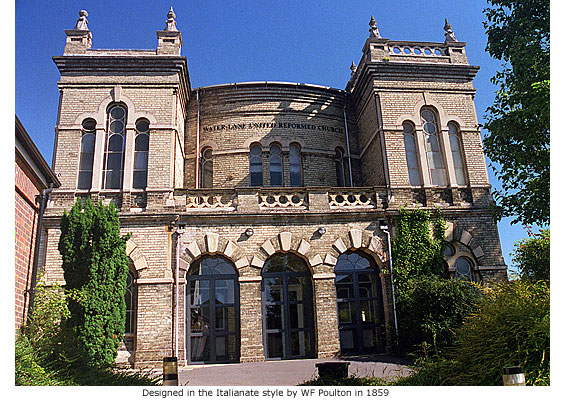
In the Middle Ages the Church had no rivals. Any criticism of the religious order was branded as heresy and in England, after 1401, was punishable by burning at the stake.
Despite this threat, the popularity of the established Church was waning and new ideas and beliefs were coming to the fore. In the 14th century an English critic named John Wycliffe formed a group known as the Lollards, who taught that each individual was entitled to his own spiritual relations with God. And in Europe the religious revolution began in 1517 when Martin Luther, a German monk, challenged the Pope’s position by forming the first reformed Protestant church. That same century Henry VIII declared himself Head of the English Church, and between 1536 and 1564 a young French lawyer, John Calvin, introduced his own type of Protestant Church that became known as Calvinism.
In the years between Henry VIII’s death (1547) and his daughter Elizabeth’s accession (1558), a struggle ensued in England between supporters of the old Catholic faith and Protestantism. Finally, in 1563, Elizabeth I made the compromise settlement, which gave birth to the Anglican Church.
|
|
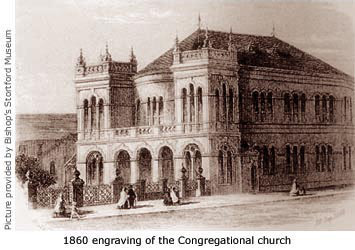 But by this time many of the Protestants exiled in Europe during the reign of the catholic Queen Mary (1553–1558) had been influenced by foreign Protestantism, and soon began to form Puritan groups in England. They were compelled to organise outside of the English Church, but two main groups emerged: the Presbyterian Church, developed by Thomas Cartwright, and the Independents – later the Congregationalists – under the inspiration of Robert Browne. Followers became known as Nonconformists. But by this time many of the Protestants exiled in Europe during the reign of the catholic Queen Mary (1553–1558) had been influenced by foreign Protestantism, and soon began to form Puritan groups in England. They were compelled to organise outside of the English Church, but two main groups emerged: the Presbyterian Church, developed by Thomas Cartwright, and the Independents – later the Congregationalists – under the inspiration of Robert Browne. Followers became known as Nonconformists.
In 1604 James I called a meeting with these Puritans in the hope of a reconciliation with the Anglican Church. But the task proved impossible and the groups went on to develop their own church organisations, soon to be joined by a third group called the Baptists.
Under the Commonwealth and Protectorate (1649–1660) the State Church was open to all denominations. Puritan groups flourished and it was during these years that another group emerged called the Society of Friends or, as their enemies called them, Quakers (See Guide 14 – Newtown Road).
But this religious freedom was short lived. After the Restoration of the monarchy in 1660 the Act of Uniformity was passed in 1662 expelling these groups from the State Church and persecuting them for their beliefs. Nonconformists became known as Dissenters and parliament passed two further acts designed to stamp out Nonconformity altogether.
One was the Test and Corporation Act. This excluded nonconformists from holding any civil or military office, and from being awarded degrees by the universities of Oxford and Cambridge. The second was The Five Mile Act, which forbade nonconformist ministers to teach in schools or come within five miles of any ‘city or town corporate or borough that sends burgesses to Parliament’. Bishop’s Stortford had indeed sent burgesses to parliament in the 14th century, but as no charter existed to say it actually was a borough, the town very soon became a haven for nonconformists.
Finally, when it was realised no amount of laws could deter people’s beliefs, the Toleration Act was passed in 1689 allowing everyone the right to worship how they pleased. Locally, a leading light for Independents had been John Payne, vicar of St Michael's (1651–1662), who was ejected from the church for refusing to subscribe to the restored religion under the Act of Uniformity. It was probably his followers who held the first meetings for independent worship outside of St Michael's, but it was Rev John Warren MA (1621–1696) who formed the first Independent community here – Congregationalists being licenced to hold their meetings in a private house at nearby Basbow Lane. The first recognised nonconformist minister in Bishop’s Stortford was *Samuel Craddock MA (1620–1706), a Fellow of Emmanuel College, Cambridge, who administered the church from 1696 until his death in 1706.
|
|
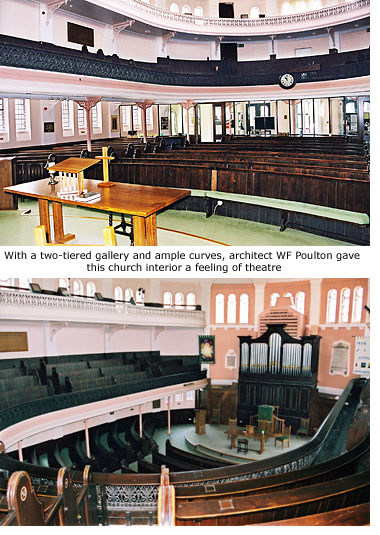 Other ministers followed Craddock and in 1717 a barn in Water Lane, used for worship since 1706, was finally bought and converted into a proper Meeting House. Rev John Angus (1724–1801) arrived in 1748, and it was largely through his efforts that a brick-built chapel replaced the barn on this site in 1767. It cost £700. 7s. 8d. and measured 44 ft by 40 ft. He lived in a house adjoining the chapel, but there was limited space here and certainly no room for a burial ground. When Rev Angus died in 1801 he was buried in St Michael’s churchyard. His house was then bought and demolished for use as a burial ground, but not until 1855 and the creation of New Cemetery at Apton Road, did local Congregationalists have their own resting place (See Guide 14 – New Cemetery). A number of tombstones from the original small graveyard in Water Lane now stand against the wall alongside the church entrance. Other ministers followed Craddock and in 1717 a barn in Water Lane, used for worship since 1706, was finally bought and converted into a proper Meeting House. Rev John Angus (1724–1801) arrived in 1748, and it was largely through his efforts that a brick-built chapel replaced the barn on this site in 1767. It cost £700. 7s. 8d. and measured 44 ft by 40 ft. He lived in a house adjoining the chapel, but there was limited space here and certainly no room for a burial ground. When Rev Angus died in 1801 he was buried in St Michael’s churchyard. His house was then bought and demolished for use as a burial ground, but not until 1855 and the creation of New Cemetery at Apton Road, did local Congregationalists have their own resting place (See Guide 14 – New Cemetery). A number of tombstones from the original small graveyard in Water Lane now stand against the wall alongside the church entrance.
By 1858 the structure of the brick-built chapel was in urgent need of attention, but when repairs were estimated at £1,200 it was decided the money would be better spent on a completely new church. The old chapel was demolished in 1859 and in its place was built the church you see today, designed by WF Poulton in the Italianate style at a cost of £2,500. Named the *Congregational church, it opened in 1860.
Further land was later acquired in front of the church entrance, the original brick pillars that marked its boundary still standing. These once supported distinctive wrought ironwork and entrance gates, but all were removed for salvage in 1914 to aid the war effort. The two pillars that formed the gateway now stand either side of the entrance to Florence Walk.
The style of this church is unusual to say the least, its designer seeming to purposfully reflect nonconformity. The northern and southern ends are rounded, the roof fairly flat, and the whole structure unsually high. Convention also plays little part in the interior of this church. The dark oak pews are purposfully curved to form a semi-circle facing the altar, and a two-tiered gallery with staged seating runs along each side wall, both tiers meeting at the southern-end to encompass the ground floor below. The windows are particularly small, but added light comes from the partly glazed roof.
When the church opened in 1860, enough seating was provided to accommodate 850 adults and 300 children. The actual membership at that time numbered around 200, but congregations were certainly larger – the Sunday School alone numbering 400 children. They were always allotted the top-most gallery.
During the 1920s the northern end of the church was remodelled: the pulpit being lowered, and the communion rail removed to provide seating around the pulpit for a choir. Further changes in the 1980s saw the, by now, old and woodworm infested pulpit replaced by a modern movable pulpit, thus allowing the whole of the dais to be used for musical concerts and recitals. Because the acoustics in the church are so good, it has since become a much sought after venue for such events. One other feature, not found in too many churches, is the carpeted dais, aisles and welcoming area.
|
|
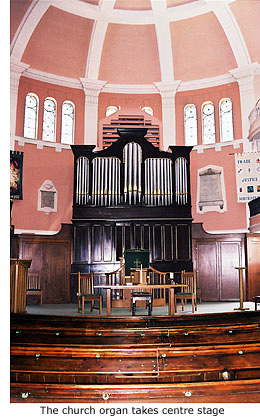 The organ purchased for the original Meeting House was replaced in 1860, and the present organ was rebuilt and installed by William Hill in 1898. An electric blower was added in 1923, and since 1952 it has been refurbished four times, the last being in 1995 when the built-in console was removed and replaced by a free–standing one. The organ purchased for the original Meeting House was replaced in 1860, and the present organ was rebuilt and installed by William Hill in 1898. An electric blower was added in 1923, and since 1952 it has been refurbished four times, the last being in 1995 when the built-in console was removed and replaced by a free–standing one.
Further repair and modernisation of the church took place in 2000/01 at a cost of £435,000. This included a new roof made of the very best Welsh slate (some of the slates from the 1767 Meeting House had been used to roof the building when built in 1859/60), a new threshold and an addition to the church entrance. This work also entailed the removal from the entrance of the large memorial commemorating Congregationalists of the town who died in World War I. It now has pride of place on the east wall within the welcoming area. Two other stone memorials remember early ministers of the church, and small brass plaques are dedicated to past members of the congregation – Alfred Slaps Barrett (1894–1933) being one of them.
An unusual entry in the church register records the burial of ‘widow Trott’ of the Red Cow public house. This opened in 1765 and stood on the outer corner of Water Lane – approximately where the pathway now leads to Waitrose supermarket.
*Samuel Craddock, while minister at Bishop's Stortford, became pastor of the congregational church in nearby Stansted-Mountfitchet, where a meeting-house was erected in 1698. He died, aged 85, on 7 October 1706 and was buried on the 11th at Wickhambrook, Suffolk. Samuel Bury, a minister from Bury St Edmunds, preached a funeral sermon on 18 October.
*John Angus was born 24 July 1724 at Styford, near Hexham, Northumberland. He entered Edinburgh University in 1741, then two years later moved to London to begin a course of ministerial training under John Eames at Moorfields Academy. In 1748 he took charge of the Independent congregation at Bishop's Stortford, where he was ordained on 26 October that same year. Married, with two daughters, he died at Bishop's Stortford on 22 December 1801. His funeral sermon, preached by his colleague William Chaplin, was published at the request of his congregation, and a monument was erected in the brick-built chapel where he had preached for over fifty years. He was survived by one of his daughters, who married a Mr Tice of Ware.
Additional information on ministers is taken from the Oxford Dictionary of National Biography
*The United Reformed Church was formed by the union of the Congregational Church in England and Wales and the Presbyterian Church of England on 5October 1972. The Re-formed Association of Churches of Christ were joined to the United Reformed Church on 26 September 1981. MORE PICTURES
|
|
|
|
|
|
|
|
|
|
|
|
|
|




 That was when their younger son Peter became involved on a full-time basis, giving up his career in the City to become managing director of Carr & Bury, with his mother as Chairman. They were then joined by Jean Barge, who managed the company's finances and later, following Ruth's death in 1985, became Chairman.
That was when their younger son Peter became involved on a full-time basis, giving up his career in the City to become managing director of Carr & Bury, with his mother as Chairman. They were then joined by Jean Barge, who managed the company's finances and later, following Ruth's death in 1985, became Chairman.

 But by this time many of the Protestants exiled in Europe during the reign of the catholic Queen Mary (1553–1558) had been influenced by foreign Protestantism, and soon began to form Puritan groups in England. They were compelled to organise outside of the English Church, but two main groups emerged: the Presbyterian Church, developed by Thomas Cartwright, and the Independents – later the Congregationalists – under the inspiration of Robert Browne. Followers became known as Nonconformists.
But by this time many of the Protestants exiled in Europe during the reign of the catholic Queen Mary (1553–1558) had been influenced by foreign Protestantism, and soon began to form Puritan groups in England. They were compelled to organise outside of the English Church, but two main groups emerged: the Presbyterian Church, developed by Thomas Cartwright, and the Independents – later the Congregationalists – under the inspiration of Robert Browne. Followers became known as Nonconformists. Other ministers followed Craddock and in 1717 a barn in Water Lane, used for worship since 1706, was finally bought and converted into a proper Meeting House. Rev John Angus (1724–1801) arrived in 1748, and it was largely through his efforts that a brick-built chapel replaced the barn on this site in 1767. It cost £700. 7s. 8d. and measured 44 ft by 40 ft. He lived in a house adjoining the chapel, but there was limited space here and certainly no room for a burial ground. When Rev Angus died in 1801 he was buried in St Michael’s churchyard. His house was then bought and demolished for use as a burial ground, but not until 1855 and the creation of New Cemetery at Apton Road, did local Congregationalists have their own resting place (See Guide 14 – New Cemetery). A number of tombstones from the original small graveyard in Water Lane now stand against the wall alongside the church entrance.
Other ministers followed Craddock and in 1717 a barn in Water Lane, used for worship since 1706, was finally bought and converted into a proper Meeting House. Rev John Angus (1724–1801) arrived in 1748, and it was largely through his efforts that a brick-built chapel replaced the barn on this site in 1767. It cost £700. 7s. 8d. and measured 44 ft by 40 ft. He lived in a house adjoining the chapel, but there was limited space here and certainly no room for a burial ground. When Rev Angus died in 1801 he was buried in St Michael’s churchyard. His house was then bought and demolished for use as a burial ground, but not until 1855 and the creation of New Cemetery at Apton Road, did local Congregationalists have their own resting place (See Guide 14 – New Cemetery). A number of tombstones from the original small graveyard in Water Lane now stand against the wall alongside the church entrance. The organ purchased for the original Meeting House was replaced in 1860, and the present organ was rebuilt and installed by William Hill in 1898. An electric blower was added in 1923, and since 1952 it has been refurbished four times, the last being in 1995 when the built-in console was removed and replaced by a free–standing one.
The organ purchased for the original Meeting House was replaced in 1860, and the present organ was rebuilt and installed by William Hill in 1898. An electric blower was added in 1923, and since 1952 it has been refurbished four times, the last being in 1995 when the built-in console was removed and replaced by a free–standing one.